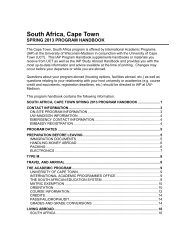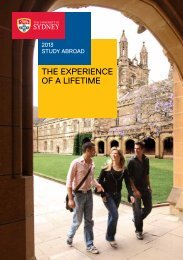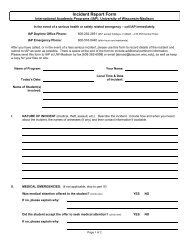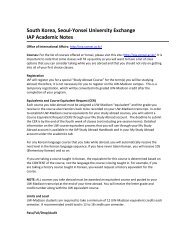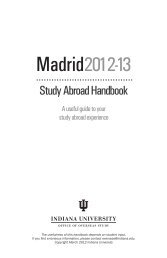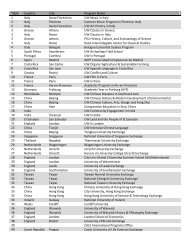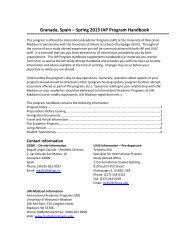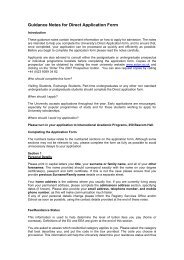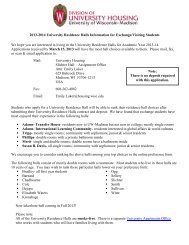NTU Taipei, Taiwan Program Handbook - UW Study Abroad ...
NTU Taipei, Taiwan Program Handbook - UW Study Abroad ...
NTU Taipei, Taiwan Program Handbook - UW Study Abroad ...
Create successful ePaper yourself
Turn your PDF publications into a flip-book with our unique Google optimized e-Paper software.
Grades will be converted according to the following scale:<br />
<strong>NTU</strong><br />
<strong>UW</strong>-Madison<br />
84-100 A<br />
80-83 AB<br />
72-79 B<br />
68-71 BC<br />
60-67 C<br />
50-59 D<br />
0-49 F<br />
Living <strong>Abroad</strong><br />
<strong>Taiwan</strong> has a population of 23 million. The larger part of the island's inhabitants are the<br />
descendants of immigrants from the various provinces of mainland China, but in particular from<br />
the southeastern coastal provinces of Fujian and Guangdong.<br />
<strong>Taiwan</strong>'s total land area is only about 36,000 square kilometers (14,400 square miles); it is<br />
shaped like a leaf that is narrow at both ends. It lies off the southeastern coast of mainland Asia,<br />
across the <strong>Taiwan</strong> Strait from Mainland China-- a solitary island on the western edge of the<br />
Pacific Ocean. To the north lies Japan; to the south is the Philippines.<br />
<strong>Taiwan</strong> lies on the western edge of the Pacific "rim of fire," and continuous tectonic movements<br />
have created majestic peaks, rolling hills and plains, basins, coastlines, and other wonders.<br />
<strong>Taiwan</strong>'s tropical, sub-tropical, and temperate climates provide clear differentiation between<br />
the different seasons. The cultural aspects are also not to be missed. The blending of Hakka,<br />
<strong>Taiwan</strong>ese, indigenous people and mainland Chinese cultures has produced a rich plethora of<br />
cultural and social color. Whether it is religion, architecture, language, living habits, or food, it's<br />
just one big exciting melting pot! Food is the best representative of this cultural mixing and<br />
matching. Aside from cuisines from different parts of the mainland such as Zhejiang, Hunan,<br />
Guangdong, Yunnan, Shanghai, Beijing, Sichuan, and others, there is also the local <strong>Taiwan</strong>ese<br />
cuisine as well as the local delicacies of each area.<br />
Located in downtown <strong>Taipei</strong>, National <strong>Taiwan</strong> University (<strong>NTU</strong>) is the first university in <strong>Taiwan</strong>.<br />
Its history can be traced back to the early 20th century, with the founding of Taihoku (<strong>Taipei</strong>)<br />
Imperial University by the Japanese in 1928. After World War II and <strong>Taiwan</strong>’s retrocession to<br />
Chinese Sovereignty, the ROC (<strong>Taiwan</strong>) government resumed the administration of Taihoku<br />
University and renamed it as “National <strong>Taiwan</strong> University’’ in 1945. Meanwhile, the University<br />
consisted of six colleges (Liberal Arts, Law, Science, Medicine, Engineering, and Agriculture) and<br />
22 departments. To date, the University continues to prosper and throughout the years has<br />
educated millions of professionals. In 2008, the University has a total of 11 colleges, 54<br />
departments, 100 graduate institutes, and 33 research centers, and the number of students<br />
reached a total of 33,416.<br />
Housing<br />
5



